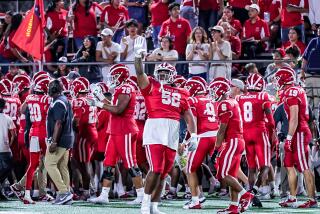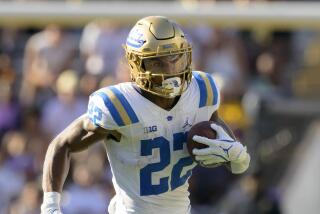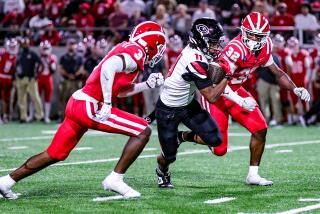Wishbone Has Been a Snap for Young : College football: Oregon State back has a good average, but he’s looking for more carries.
In the football recruiting season of 1989, J.J. Young of South Pasadena High could look back on his high school career with some regret.
He was, he believed, one of the most explosive offensive high school football players in Southern California. He was certainly one of the fastest.
Problem was, not many knew it.
He had been used primarily as a defensive back and wasn’t being widely recruited.
Among the schools that came calling: The U.S. Military Academy and the U.S. Naval Academy.
Among those that didn’t: USC and UCLA.
Now a 5-foot-10, 192-pound senior halfback at Oregon State and headed for a 1,000-yard rushing season, Young and his teammates will play USC Saturday afternoon at Corvallis, Ore., in a game in which Young says he has a point to prove.
He made his point a year ago, in a way. In a 34-9 loss to USC at the Coliseum, he gained 101 yards in 13 carries, with a long run of 37 yards.
“I never really wanted to go to USC or UCLA, I just wanted to beat them,” he said. “But it upset me that neither school recruited me. I felt then I was good enough to play for either one, and, of course, I think I’ve shown that.”
His old South Pasadena High coach, Fred Cuccia, takes it a bit further.
“If USC or UCLA had taken J.J., given him the ball 30 times a game, he’d be on his way to a 1,000-yard, All-American season for them,” he said.
“He’s a better running back than either school has now. The problem was, he was a tremendous defensive back in high school and that’s how he was recruited.
“When he went to Oregon State, he went as a DB. But when I saw that Jerry Pettibone came in (in 1990) and was installing the wishbone, I knew Pettibone would switch him to offense the first time he saw J.J. run.”
He did. Four seasons later, here’s what Pettibone has to say about Young:
“This is my 29th year in coaching and I’ve seen some of the great running backs who’ve played college football--Joe Washington, Greg Pruitt, Billy Sims. . . . I think J.J. is in that category. He has the kind of explosiveness to hit the home run every time he handles the ball.
“He can also catch the football and he’s an outstanding blocker.”
On Saturday, with 28 yards, Young will tie Terry Baker for ninth place on OSU’s all-time rushing list.
In fact, he can move to seventh with a 60-yard game.
Also from the file:
--Young has six 100-yard games, despite never having had more than 22 carries in any game.
--Young had 68- and 57-yard runs against Arizona State and Wyoming this season.
--As a junior last year, he ranked third in the nation with a 7.0-yard average. He’s at 5.6 yards a carry this season.
--His 955-yard 1993 season is the fourth highest in Oregon State history.
Young can only envy those who are given more carries.
The Pac-10’s leading rusher, Napoleon Kaufman of Washington, has 118 carries and 670 yards. UCLA’s Sharmon Shah has 95 for 482. USC’s Shawn Walters has 87 for 410.
Young’s 51 for 283 ranks him ninth in the conference.
“Sure, I’d like to get the ball more, but you play the card you’ve been dealt,” he said.
“We run the wishbone here, and that’s the way it is. Everyone would probably like to change some things in their life. But the bottom line is winning, and that’s basically what I’m trying to do.”
Young was clocked in 4.37 for 40 yards both in high school and at Oregon State. In a high school track meet once, he beat Russell White in the 100.
“And that’s not a phony 40 time, either,” he said. “That’s in football shoes and on the turf, not on a track.”
You’d think such a guy, with speed, sufficient size and grades--Young earned his economics degree last June and is now in Oregon State’s graduate school, working for a master’s in interdisciplinary studies--would have been sought from here to Notre Dame in 1989.
Said Cuccia: “The first time J.J. ever handled the ball for me on offense, he went 63 yards for a touchdown. He was special. He was the most dangerous offensive player in the San Gabriel Valley.
“My last year coaching was J.J.’s junior year. The coach who succeeded me didn’t use him right, and at midseason his senior year J.J. called me. He was terribly disappointed.
“I told him to stick it out, that I’d make some calls for him during recruiting season.”
Young was recruited by an odd mix of schools: Syracuse, Iowa State, Oregon State, Hawaii, Arizona State and Cal.
“Cal signed Russell White and Arizona State got Mario Bates, so I scratched those two,” Young said.
“Syracuse and Hawaii were too far. I wanted to go somewhere where my mom wouldn’t be on my doorstep every night, yet close enough where she could see me play some games.”
It came down to Oregon State. Young signed without a visit. At the time, in Oregon State’s pre-wishbone years, under then-Coach Dave Kragthorpe, Young figured he’d have a chance to be the main man at running back.
Then came Pettibone, and the wishbone--an offense that emphasizes running but also one that spreads around the carries.
After playing most of his freshman season with a knee brace that restricted his cutting ability, Young then lost almost all of his sophomore season because of an early-season stress fracture of his right leg.
In 1993, the real J.J. Young emerged.
“I started and finished the season healthy,” he said. “My attitude was, ‘Now show ‘em who you are. Show ‘em you could play anywhere in the Pac-10.’ ”
Young hopes that the guys who make draft day decisions for NFL clubs will look at Oregon State films.
“I hope someone notices that my yardage has come on a lot of different kinds of runs, and I hope that someone sees I can block, too,” he said.
“At Arizona (where the Beavers lost last Saturday, 30-10) my blocking assignment was Tedy Bruschi, and I did pretty good, for a 192-pound guy.”
Bruschi is a 6-1, 255-pound All-American defensive end who led the conference in sacks last year.
“Bruschi was my assignment, on five plays,” Young said. “I slowed him down on every play and twice I cut him and got him on the ground.”
More to Read
Go beyond the scoreboard
Get the latest on L.A.'s teams in the daily Sports Report newsletter.
You may occasionally receive promotional content from the Los Angeles Times.






